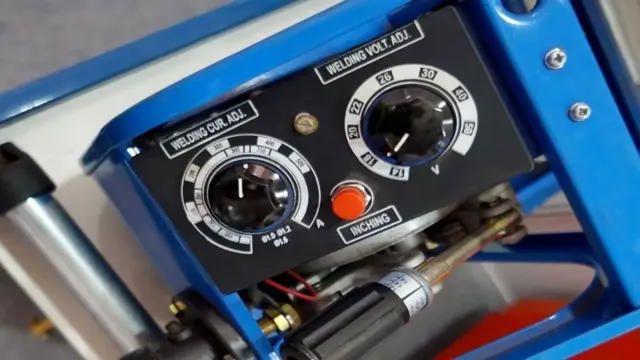Welding machines have been a revolution in the world of metal fabrication. They offer an efficient way of fusing metals together and completing various welding tasks. However, one question that many hobbyists and professionals alike have is how much electricity a welding machine uses.
Electricity consumption is a crucial factor when it comes to productivity and welding costs, and knowing how to calculate energy consumption can help welders save money and keep their projects running smoothly. In this blog post, we will explore how welding machines consume electricity and discuss ways to optimize power usage. So, let’s dive in and uncover the electricity usage secrets of welding machines!
Understanding the Power Output of Welding Machines
If you’re wondering how much electricity a welding machine uses, it really depends on the power output of the machine. Welding machines come in different sizes and types, each with varying power ratings. The power output of a typical welding machine ranges from 90 amps to 600 amps.
The higher the amps, the more electricity the machine will use. The power rating of a welding machine affects its performance, which is why it’s important to choose the right machine for the job. For example, a small 90-amp welding machine may be good for light tasks, such as welding thin metals, while a 600-amp machine is better suited for heavy-duty welding jobs.
The power consumption of a machine is also influenced by the type of welding process used, such as MIG, TIG, or Stick welding. Overall, understanding the power output of a welding machine is crucial in determining its electricity usage and performance.
Factors That Affect Power Consumption
Understanding the power output of welding machines is crucial to controlling and reducing power consumption. The power output of a welding machine is determined by a variety of factors, including the type of welding process, the thickness of the material, and the type of electrode used. Welding machines with high power outputs are often used for thicker materials, while lower power outputs are more suitable for thinner materials.
Additionally, welding machines equipped with energy-saving technology can significantly reduce power consumption, such as inverter technology. It’s also important to note that understanding and adjusting welding parameters, such as voltage and amperage, can help reduce power consumption while maintaining high-quality welds. By understanding the factors that affect power consumption, welders can make informed decisions to reduce their energy usage, save money, and reduce their carbon footprint.

Calculating the Energy Consumption of Welding Machines
Welding machines are a crucial aspect of many industries, including construction and manufacturing. However, their energy consumption can be a source of concern for both the environment and the bottom line. To understand the power output of welding machines, it’s essential to consider the amperage and voltage they require.
Amperage refers to the amount of electrical current flowing through the machine, while voltage indicates the amount of force that’s needed to move that current. By multiplying these two values, you can determine the power output of the machine, measured in watts. This information is crucial for calculating the energy consumption of welding machines and ensuring that they’re operating efficiently and sustainably.
By paying attention to the power output of welding machines, businesses can reduce their carbon footprint and save money on energy costs, all without sacrificing performance or quality.
Estimating Electricity Use for Common Welding Machines
If you’re wondering how much electricity a welding machine uses, it really depends on the type of machine you’re using. For example, a 120-volt MIG welder can use up to 20 amps, while a 240-volt model may use up to 70 amps. Similarly, a stick welder typically uses between 50 and 200 amps, while a TIG welder can use anywhere from 10 to 250 amps.
It’s worth noting that the amount of energy a welding machine uses also varies based on how long it’s in use for, the thickness of the materials being welded, and the type of welding technique being employed. Overall, if you’re looking to estimate your electricity usage from welding, it’s important to take into account not only the type of machine you’re using, but also the specific circumstances of your welding project.
Stick Welding Machines (SMAW)
When it comes to stick welding machines, one important aspect that needs to be considered is the electricity usage. Before starting a welding job, it’s important to know how much energy will be consumed by the machine. An estimation of electricity usage can help you plan the welding job accordingly, ensuring that you have enough power to complete it without any interruptions.
Larger welding machines consume more electricity, so it’s essential to choose a machine that is appropriate for the welding job at hand. By doing so, you can save on energy costs and also protect the machine from damage due to inadequate power supply. In conclusion, before starting any welding project, it’s important to estimate the electricity usage of your stick welding machine to ensure a seamless welding experience.
MIG Welding Machines
MIG welding machines are a popular choice for welding due to their efficiency and high-quality output. When it comes to estimating electricity use for common welding machines, it’s important to consider a few factors. For MIG welding machines, the main factor to consider is the wire feed speed and the voltage used.
This will determine the amperage and overall electricity consumption. As a general rule of thumb, a MIG welding machine with a 120-volt input and a 20% duty cycle will use around 22 amps of electricity. However, for a MIG welding machine with a 240-volt input and a 40% duty cycle, the electricity use could be around 60 amps.
It’s important to know your specific machine’s input voltage and duty cycle to accurately estimate its electricity consumption. By doing so, you can ensure that you have the appropriate power supply to fuel your welding projects and avoid any potential power outages or electrical issues.
TIG Welding Machines
TIG welding machines have become one of the most popular welding technologies in the modern era. They are efficient, precise, and produce high-quality welds. But, to get accurate results from your TIG welding machine, it is important to know the estimated electricity usage.
Different types of welding machines have different power requirements, which can impact your energy bill. A TIG welding machine typically requires around 50 amps of power, although the actual amount of power used depends on the specific model, manufacturer, and the type of material you are welding. Some TIG welding machines come with built-in power meters, which can help you keep track of the amount of electricity used during a project.
However, if your machine does not have this feature, you can still estimate the electricity usage by calculating the amps and the duration of use. In conclusion, estimating electricity usage for TIG welding machines is crucial to prevent any unwanted surprises on your electricity bill.
Reducing Energy Consumption in Welding Operations
When it comes to welding operations, it’s important to consider energy consumption. If you’re wondering how much electricity does a welding machine use, it really depends on the type of machine and the type of welding being done. For example, a stick welding machine typically uses around 5,500 watts per hour, while a MIG machine can use anywhere from 70 to 500 watts per hour.
However, there are ways to reduce energy consumption during welding operations. One way is to use energy-efficient processes such as pulse welding, which uses less power while still achieving high-quality welds. Another way is to properly maintain welding equipment, as dirty or worn components can increase energy consumption.
By being mindful of energy usage and implementing energy-saving techniques, welding operations can become more sustainable and cost-effective in the long run.
Tips for More Energy-Efficient Welding
Welding is an essential process for various industries, but it can also consume a lot of energy and lead to high costs. Fortunately, there are several ways to reduce energy consumption in welding operations. One of the most effective ways is to choose the right welding machine.
Modern machines are designed to be more energy-efficient, and they can significantly reduce your electricity bill. Another way to save energy is to choose the right welding process. Some welding processes, such as gas tungsten arc welding (GTAW) and gas metal arc welding (GMAW), require less energy than others.
Additionally, it’s important to use the right welding technique and equipment settings. Higher voltage and amperage settings can result in energy wastage, so it’s best to use lower settings that still provide adequate penetration and weld quality. Lastly, make sure to maintain your equipment properly.
A well-maintained machine uses less power and lasts longer, reducing the need for frequent replacements and saving you money in the long run. With these tips, you can enjoy more energy-efficient welding operations without compromising on quality.
Alternative Energy Sources for Welding Operations
Welding operations are energy-intensive, but there are alternative energy sources that can reduce energy consumption and minimize the carbon footprint of the process. One option is to use solar power to generate electricity for welding equipment. Solar panels can be installed on a building’s roof or in an adjacent area and can provide a sustainable and cost-effective source of power.
Another alternative is the use of wind turbines, which generate electricity from wind energy, and can be installed in areas with high wind speeds. Biomass and biogas also offer renewable energy sources that can be used to fuel welding equipment. With biomass, organic materials such as wood chips, sawdust, and agricultural waste are burnt to generate heat that can be used for welding.
Biogas, on the other hand, is produced by the anaerobic digestion of organic matter, and can be used to power generators that can power welding equipment. By choosing to use alternative energy sources for welding operations, businesses can reduce their carbon footprint, cut energy costs, and contribute to a more sustainable future.
Conclusion and Final Thoughts
In conclusion, the amount of electricity a welding machine uses is dependent on numerous factors, including the type of machine, the size of the project, and the welding technique used. However, one thing is for sure – welding machines are electricity-hungry beasts, consuming electricity like a kid in a candy shop. So, if you want to save on energy costs, it’s important to choose an efficient machine, be mindful of your welding technique and turn off the machine when it’s not in use.
Remember, every little bit of energy conservation helps our planet and your wallet.”
FAQs
What is the average power consumption of a welding machine?
The average power consumption of a welding machine is 6.5 kW per hour.
Can a welding machine run on a generator?
Yes, a welding machine can run on a generator, but make sure the generator has enough power to supply the machine.
Is it cheaper to run a welding machine on a 110V or 220V outlet?
It is cheaper to run a welding machine on a 220V outlet because it requires less amperage to run and is more efficient.
How much does it cost to operate a welding machine per hour?
The cost to operate a welding machine per hour depends on the cost of electricity in your area. On average, it could range from $0.50 to $1.50 per hour.
Can a low amperage welding machine save energy?
Yes, a low amperage welding machine can save energy because it consumes less electricity compared to high amperage machines.
How do I calculate the power consumption of my welding machine?
To calculate the power consumption of your welding machine, multiply the voltage by the amperage. For instance, a welding machine with 220V and 30A will consume 6,600 watts or 6.6 kW per hour.
What are the energy-saving tips for welding machines?
Some energy-saving tips for welding machines include using low amperage machines, adjusting the duty cycle, avoiding idle time, and turning off the machine when not in use.






